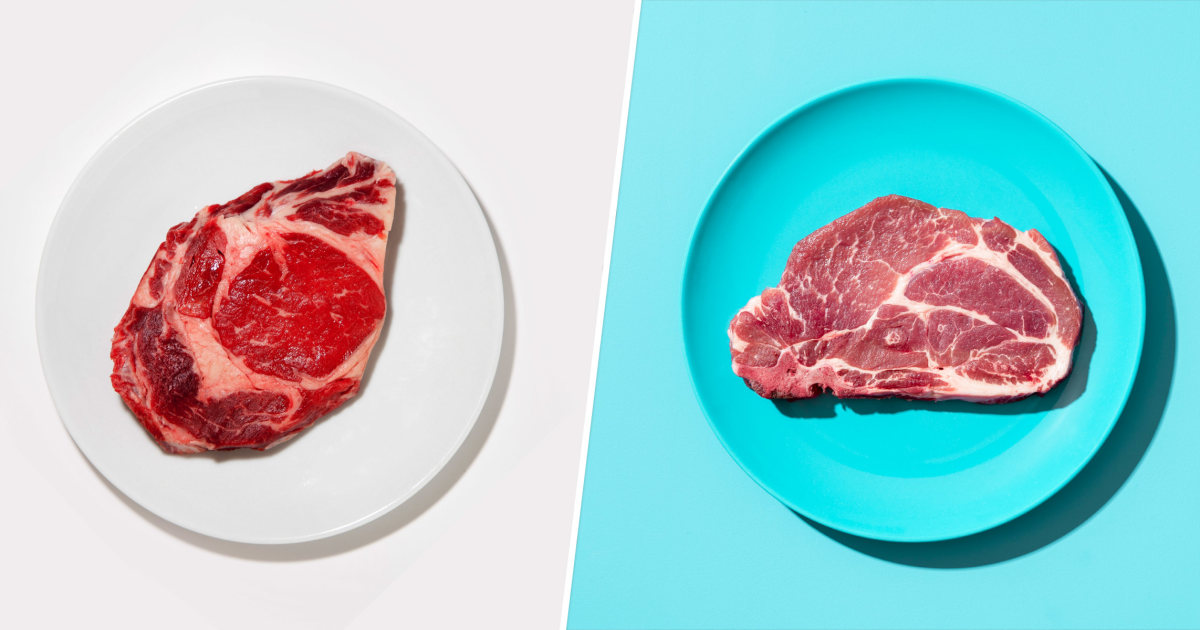
Pork and beef are high-protein champs on the dinner menu. Both meats are tasty, satisfying and versatile. If you choose lean cuts and control the portions, they can be low in saturated fat and part of a heart-healthy diet, dietitians say.
People trying to lose weight or manage it can see benefits, too, like satiety with fewer calories.
Both pork and beef are excellent sources of complete protein, but they have different nutritional strengths, says Patricia Bannan, a registered dietitian in Los Angeles and author of “From Burnout to Balance.”
Plus, “the preparation method can make or break the nutritional value of any meat,” Bannan tells TODAY.com.
Like many Americans, registered dietitian Elisabetta Politi frequently debates about whether to cook beef or pork for dinner. One option typically wins for several reasons, says Politi who works at the Duke Lifestyle and Weight Management Center in Durham, North Carolina.
So which is healthier: pork or beef? Here’s what the experts say.
Is pork a healthy meat?
Pork is a good source of protein, vitamin B12 and thiamin, and minerals — particularly heme iron, which is well absorbed by the body, Politi says.
Vitamin B12 keeps blood and nerve cells healthy, while thiamin (also known as vitamin B1) is key for a healthy metabolism.
Protein is important for satiety, tissue repair and muscle growth.
Iron is needed to make healthy red blood cells that deliver oxygen to all parts of the body, the National Institutes of Health notes.
Pork is considered a red meat, according to the U.S. Department of Agriculture.
What cut of pork is healthiest?
Both dietitians recommend pork tenderloin as the healthiest and tastiest cut.
“Pork tenderloin is actually one of the leanest protein sources available — comparable to skinless chicken breast,” Bannan says.
“It’s an excellent choice for people watching their calories while maintaining protein intake.”
A 3-ounce serving of roasted pork tenderloin contains:
- 122 calories
- 22 grams of protein
- 3 grams of fat
Pork chops are also a great choice, Politi adds. She recommends choosing lean ones, unless the fat can be trimmed. Pork sirloin and tenderloin are low in saturated fat, she adds.
In general, look for minimal visible fat and “loin” cuts, which are typically leanest, Bannan advises.
Types of pork to limit
Limit the processed types of pork, like cured bacon and ham, the dietitians say.
They’re higher in salt and cured with nitrates and nitrites, Politi notes.
Processed meat may increase cancer risk and should be eaten sparingly, if at all, the American Cancer Society advises.
Is beef healthy to eat?
Beef is also a good source of complete protein, vitamins and minerals. It excels in vitamin B12 content and provides even more heme iron than pork, the dietitians note.
“Lean beef is one of our most concentrated sources of easily absorbable iron, which is particularly important for menstruating women and athletes,” Bannan says.
“A single serving can provide up to 15% of your daily iron needs.”
When serving beef, she advises pairing it with foods rich in vitamin C, which helps the body absorb iron. Good options include yellow bell peppers and dark leafy greens, which provide both iron and vitamin C.
Beef is a red meat. It’s higher in saturated fat than many other proteins, so it’s important to buy lean cuts, Politi says.
What type of beef is the healthiest?
The dietitians recommend looking for lean “round” or “loin” cuts.
When it comes to beef grades, which indicate the quality of beef, buy Choice or Select over Prime for less fat, Bannan advises.
Lean ground beef can be another healthy option, she says. Choose at least 85% lean, according to the American Heart Association. You can also buy 90% lean or higher, Bannan says.
Pork vs. beef: Which is healthier?
It depends on what your needs and goals are.
Pork and beef have a similar nutrition profile, but there are three major nutritional differences between the two meats.
Beef is a better source of iron and vitamin B12 than pork, Politi says.
“For athletes, lean beef can be particularly beneficial due to its high iron content, which supports oxygen transport during exercise,” Bannan adds.
But pork tends to be naturally leaner than beef, so pork tenderloin may be a better option for weight loss because it’s satisfying with fewer calories, she says.
It’s the meat Politi favors.
“I am more likely to buy pork because it’s less expensive and I am more skilled at cooking it. If I have guests, I usually ask for food preferences or allergies as many prefer not to eat pork or red meat in general,” she says.
How much pork or beef is OK to eat?
A serving size of both meats is about 3 to 4 ounces, or about the size of a palm of a woman’s hand or a deck of cards.
Politi suggests eating no more than 8 ounces of any red meat per week.
The calorie and fat content for both pork and beef will depend on the cut and the cooking preparation, both dietitians say. Grilling, broiling, roasting, air frying and pan searing with minimal oil are the recommended cooking methods.
Fill the rest of your plate with dark leafy greens, fiber-rich vegetables and whole grains to create a healthy meal, Bannan says.
“If eaten in moderation and paired with other healthy foods, both pork and beef are part of a heart healthy diet,” she adds.
“Mixing it up with other sources of protein, whether it’s fish or plant-based protein like lentils, is going to give you a more robust diet in terms of nutritional quality.”
